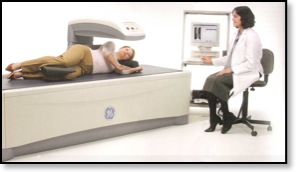What is a Bone Density Scan (DEXA)?
Bone density scanning, also called dual-energy x-ray absorptiometry (DXA or DEXA) or bone densitometry, is an enhanced form of x-ray technology that is used to measure bone loss. DEXA is today's established standard for measuring bone mineral density (BMD).
An x-ray (radiograph) is a painless medical test that helps physicians diagnose and treat medical conditions. Radiography involves exposing a part of the body to a small dose of ionizing radiation to produce pictures of the inside of the body. X-rays are the oldest and most frequently used form of medical imaging.
DEXA is most often performed on the lower spine and hips. Portable DEXA devices, including some that use ultrasound waves rather than x-rays, measure the wrist, fingers or heel and are sometimes used for screening purposes.
To find out more, visit RadiologyInfo.
Bone density scanning, also called dual-energy x-ray absorptiometry (DXA or DEXA) or bone densitometry, is an enhanced form of x-ray technology that is used to measure bone loss. DEXA is today's established standard for measuring bone mineral density (BMD).
An x-ray (radiograph) is a painless medical test that helps physicians diagnose and treat medical conditions. Radiography involves exposing a part of the body to a small dose of ionizing radiation to produce pictures of the inside of the body. X-rays are the oldest and most frequently used form of medical imaging.
DEXA is most often performed on the lower spine and hips. Portable DEXA devices, including some that use ultrasound waves rather than x-rays, measure the wrist, fingers or heel and are sometimes used for screening purposes.
To find out more, visit RadiologyInfo.
© 2011 North Texas Internal Medicine Assoc.

